The Public Life of Sherlock Holmes: The D&D Adventure (Board) Games
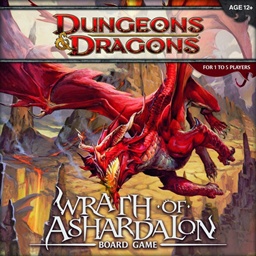 Back in 2010, Wizards of the Coast (WotC) decided to put out a board game that replicated playing 4th Edition Dungeons and Dragons. Now, 4th Edition was a debacle, but Castle Ravenloft, which was the first of four games in the Dungeons and Dragons Adventure Game line, is quite the opposite. It’s a cooperative dungeon crawl with set scenarios but random tile placement and in which the game itself serves as the dungeon master.
Back in 2010, Wizards of the Coast (WotC) decided to put out a board game that replicated playing 4th Edition Dungeons and Dragons. Now, 4th Edition was a debacle, but Castle Ravenloft, which was the first of four games in the Dungeons and Dragons Adventure Game line, is quite the opposite. It’s a cooperative dungeon crawl with set scenarios but random tile placement and in which the game itself serves as the dungeon master.
I’ve not played Castle Ravenloft (previously discussed here at Black Gate), which uses the iconic D&D setting. However, I am pretty familiar with 2011’s follow-up, Wrath of Ashardalon. Ashardalon is a red dragon and the party explores a cave system to eventually try and stop him. It was followed by The Legend of Drizz’t (here atBlack Gate), based on the NY Times best-selling books by R. A. Salvatore. I have also played this one several times. It looked like that was the end of the series, but last year, WizKids stepped in and in conjunction with WotC, produced a fourth installment, Temple of Elemental Evil (and also here at Black Gate). I own that but haven’t played it yet.
The games are all quite similar. There were a few changes in the first three, but I would say they’re at least 90% the same, maybe even a bit more. Temple added a campaign mode, (where you can keep items between scenarios!) that looks to be a notable change and one I look forward to exploring.
THE PARTS
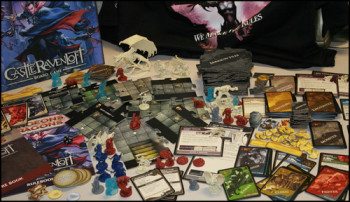 Each game comes with about a dozen sheets of interlocking tiles that make up the dungeon, as well as on average, 200 Encounter, Monster, Treasure and Hero cards that are the game play, plus tokens of various types. There’s a nice glossy, short, easy to read rule book as well as a similar Scenario book. And of course, one 20 sided die. But the real draw is the figures.
Each game comes with about a dozen sheets of interlocking tiles that make up the dungeon, as well as on average, 200 Encounter, Monster, Treasure and Hero cards that are the game play, plus tokens of various types. There’s a nice glossy, short, easy to read rule book as well as a similar Scenario book. And of course, one 20 sided die. But the real draw is the figures.
Each has about 40 heroes and monsters! They are not painted and all are reissues of official D&D minis. But where else are you going to get this many minis for the price? And you can always paint them or buy painted versions (I did that for some) if you want to jazz it up. For me, the components are well worth the cost. It all comes in a HUGE, sturdy box. I sleeved one game and everything still fits (though not in the same places). If you like to buy board games that come with a LOT of stuff, these games absolutely are the kind of thing you’re looking for. And nothing looks cheap: they use solid components.
THE PARTY
This is a cooperative game for 1-5 players. Each game starts with a solo scenario, and if you’re playing alone, it’s simple to control multiple heroes in the other scenarios. But this game is far more fun with two or more players. Each player gets an oversized hero card and a figure. Actions are taken by using cards: At-Will powers are ‘normal’ attacks that can be reused. Daily powers are special ones that usually do more damage and are flipped over after being used once. Unless an in-game event lets you turn the card back face-up, it can’t be used until the next scenario. And Utility powers are some other type of action; sometimes used in conjunction with another attack. They may or may not have to be turned over.
EXPLORING
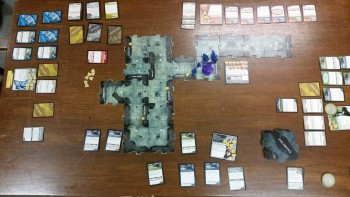 Heroes move a certain number of squares. When they reach the end of a tile, a new tile is laid and connected to it. A monster card is drawn and a figure is placed on that new tile (I haven’t mentioned yet: these games are hard!). The player who placed the monster “controls” it. More on that in a bit.
Heroes move a certain number of squares. When they reach the end of a tile, a new tile is laid and connected to it. A monster card is drawn and a figure is placed on that new tile (I haven’t mentioned yet: these games are hard!). The player who placed the monster “controls” it. More on that in a bit.
A new tile with a white triangle is good. One with a black tile: not so much. Those require that an Encounter Card be taken. In Ashardalon, encounters are ALWAYS bad. Traps, attacks, volcanic sprays – they are 100% bad news. Drizz’t actually added a few good encounter cards, which you really appreciate when you draw one.
MONSTERS
Each monster card has clear instructions on what the monster does on its turn. For example, if it is adjacent to a hero, it attacks with claws and it tells what the attack bonus and damage are. If it is not adjacent to a hero, then it moves one tile towards the closest hero.
GAME PLAY
Each player’s turn consists of three phases: Hero, Exploration and Villain.
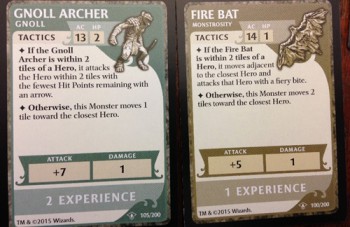 In the Hero Phase, a player gets to attack and./or move. Each monster has an Armor Class and Hit Points (usually 1 or 2). The player uses one of their power cards: almost always giving a bonus. That bonus is added to a d20 roll. If the sum is equal or greater than the monster’s AC, it’s a hit, doing whatever the specified damage is. If the monster is killed, it’s removed from the board and its card goes in the experience pool (each monster card has an experience value at the bottom). The hero gets a Treasure card, which can be given to any party member at that time.
In the Hero Phase, a player gets to attack and./or move. Each monster has an Armor Class and Hit Points (usually 1 or 2). The player uses one of their power cards: almost always giving a bonus. That bonus is added to a d20 roll. If the sum is equal or greater than the monster’s AC, it’s a hit, doing whatever the specified damage is. If the monster is killed, it’s removed from the board and its card goes in the experience pool (each monster card has an experience value at the bottom). The hero gets a Treasure card, which can be given to any party member at that time.
In the Exploration Phase, the player places a new tile if they moved to the edge of an existing one, draws a monster card and (almost always) places a monster on the new tile. They keep the card, which is ‘controlling’ it.
Things get rough in the Villain Phase. If you got a black triangle, or if you didn’t explore to the edge and place a new tile (which keeps you from just standing around and fighting, healing, etc), you draw one of those nasty Encounter Cards. The encounter sometimes impacts all players, not just the one who drew it.
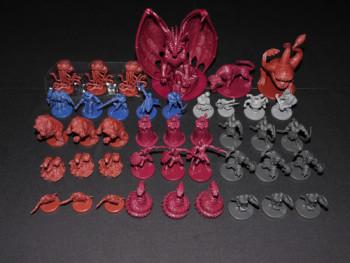 If there is a villain on the board, you activate it and do what its card says. Defeating the villain is often the victory condition for a scenario. Finally, the player activates any monsters and traps they control. So, if you have monster cards in front of you, those monsters get to move/attack. Likewise, trap cards that were drawn can come into play. The monsters don’t necessarily attack the player they are controlled by: the actions on their card determines where they go and what they do.
If there is a villain on the board, you activate it and do what its card says. Defeating the villain is often the victory condition for a scenario. Finally, the player activates any monsters and traps they control. So, if you have monster cards in front of you, those monsters get to move/attack. Likewise, trap cards that were drawn can come into play. The monsters don’t necessarily attack the player they are controlled by: the actions on their card determines where they go and what they do.
After any combats are played out and the Villain Phase ends, the next player begins their Hero Phase. There is a LOT of fighting in this game. If a player reaches 0 hit points, they are unconscious. At the start of their next turn, they can redeem one of the party’s Healing Surges (if any are left) and ‘wake up’ at half their hit point total. Usually, if a party runs out of healing surges and somebody “dies,” the game ends as a loss.
LEVELING UP
I mentioned the experience pool. If a player rolls a natural 20, they can redeem five experience points and level up. That means turning their Hero card over. It powers up the hero with more hit points, better armor class and an extra power card. It can make a difference. Also, the party can use five experience points to negate an Encounter card. Sometimes, it’s worth it to avoid the damage. Especially late in a game when rolling a 20 seems less likely.
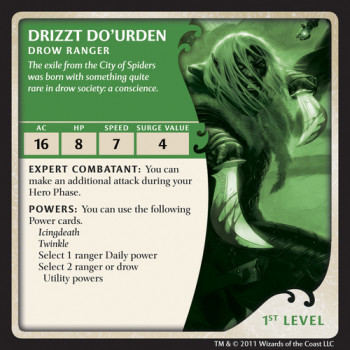 In the first three games, heroes start completely over each new scenario. Everyone is first level, no items are kept from the prior game: there’s no ongoing play. Temple changes that, with characters keeping their stuff and being able to sell excess treasure in the town (yes, there’s a town, though it’s not Hommlet!) and buy bonuses. That’s a function of the campaign mode.
In the first three games, heroes start completely over each new scenario. Everyone is first level, no items are kept from the prior game: there’s no ongoing play. Temple changes that, with characters keeping their stuff and being able to sell excess treasure in the town (yes, there’s a town, though it’s not Hommlet!) and buy bonuses. That’s a function of the campaign mode.
STRATEGY
I’ve played Wrath and Legend solo, running anywhere from one to four characters myself. I like it, but it’s kind of a mechanical grind (though I sometimes find myself pretty darn entertaining!). I found three players to be the start of the sweet spot, but it can be there at two. With multiple players, you really get into the strategy discussions of who should do what and when. And even what should the monsters do. And of course, the fun and commentary on a bad roll is part of the experience.
HOUSE RULES
The rules are pretty simple, though in some areas the rulebook is vague. It is very easy to add house rules to change the game any way you want. One that we’ve played with often is to not activate the monsters on the turn they are placed, but the on the next one. Which gives the heroes first attack. It definitely makes the game easier (though not easy). Also, most scenarios give you two healing surges. We usually play one surge per number of players. That has definitely extended many a scenario. You can also go old school and make a Hero’s roll of one a ‘fumble’ and implement some penalty, such as an adjacent hero is hit instead of the monster, or that power is “dropped” for the next round. There is a lot of room to make changes to the game.
COMPATABILITY
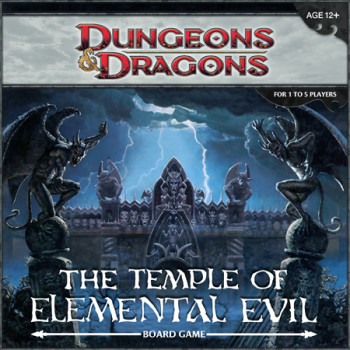 All monsters, heroes, tiles and cards from any game can be used in any other game. Some are tied to specific scenarios and might not really make thematic sense in another game, but what the hey. Because everything works with everything else, the games are pretty similar. Personally, I don’t mind, though I haven’t mixed anything up yet.
All monsters, heroes, tiles and cards from any game can be used in any other game. Some are tied to specific scenarios and might not really make thematic sense in another game, but what the hey. Because everything works with everything else, the games are pretty similar. Personally, I don’t mind, though I haven’t mixed anything up yet.
Wrath is a grind: it is a very tough dungeon crawl. We’ve incorporated a couple house rules that have helped us stay alive. Legend of Drizz’t incorporated Stances, which I think makes Drizz’t and Catti Brie overpowered. Coupled with the “good” Encounter and Monster cards, I think Legend is easier than Wrath. It’s still not a walk in the park, but I do think it can be easier to win. I myself prefer Wrath a little more, but I can understand the appeal of Legend. Legend also has a couple of different scenario types that weren’t in Wrath, giving that game a little more diversity.
Again, I haven’t played Ravenloft, but having read the rulebook, I think it plays very similar to Wrath. And Temple, with the campaign mode, probably has the most unique feel of the four.
If you are a fan of Salvatore’s books, you should probably go with Legend of Drizz’t. It uses named characters and villains from the books. The other three games use generic D&D classes, like a Dragonborn Wizard, Elven Paladin, Gold Dwarf Cleric, etc. Which is fine, but you are actually playing the Drizz’t characters in that game. Of course, you can take those characters, play Wrath of Ashardalon and write your own tale!
I haven’t explored this aspect really at all, but there are a few fan made scenarios that you can download which combine some or all of the games. If you had the time, you could certainly mix some or all of the games together and come up with your own adventure. The diversity of monsters and treasures certainly gives you flexibility in creating something fun. Maybe even something that pits villains from two different games against each other, with the players in the middle. One scenario in Legend of Drizz’t has a randomly determined hero become the villain in the middle of the scenario, and it’s remaining heroes vs. villain (monsters can attack both) to the end of the game. Creative Game Masters have a lot options of mixing and matching.
GATEWAY GAME
The Adventure Game System is an excellent way to introduce someone to the concept of RPGs. There’s not real ‘role playing,’ but it’s basically an RPG on a board. And it’s a heck of a lot easier to learn than an actual RPG would be. It also appeals to veteran RPGers like me because it’s got the elements of an RPG, playable in an hour or two. A recent gaming group consisted of myself (began playing D&D in the late seventies), one Warcrafter, one PC gamer and a total newbie. And we all enjoyed it. This one appeals to all experience levels.
DUNGEON COMMAND
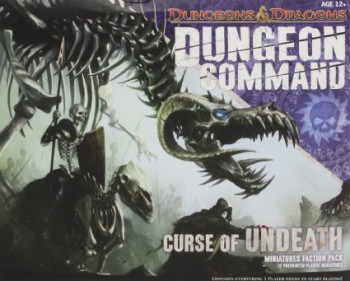 Dungeon Command was another WotC game that used minis and cards (no dice) for tactical combat war gaming. There were several sets and they were used to battle each other. I’ve never seen them, but each one included cards so that you could use them with the Adventure System games. I didn’t find that worth the price, but it might appeal to others. I’d spend a little more and just buy another Adventure System game (wait – I did!).
Dungeon Command was another WotC game that used minis and cards (no dice) for tactical combat war gaming. There were several sets and they were used to battle each other. I’ve never seen them, but each one included cards so that you could use them with the Adventure System games. I didn’t find that worth the price, but it might appeal to others. I’d spend a little more and just buy another Adventure System game (wait – I did!).
BUY ONE!
Pathfinder’s Rise of the Runelords Adventure Card Game is my favorite board game. But these D&D Adventure Games have moved pretty darn close in the standings. They’re a great way to get an RPG fix; they require less time than an RPG session; you can play with fewer people or by yourself; and you get a bunch of cool minis with them. The more I’ve played Wrath and Legend, the more I’ve liked them and I’m hoping to try out Temple soon. I definitely think these games are more fun than Runebound, which I wrote about here, here and here.
They’re fun and if you play a couple of scenarios, I think you’ll find it was a purchase well worth the cost. I don’t know of any plans for another installment in the series, but with the success of 5th Edition, maybe there’s something they’d like to cross-promote, even if the mechanics of the game would have to remain 4th Edition to maintain compatibility. With Ravenloft and Drizz’t already covered, Dark Sun, anyone?
UPDATE – I wrote up a play through of Temple, which you can read about here: with lots of pictures.
Other Game/RPG-related posts I’ve done here at Black Gate:
The Lost Lands for Pathfinder
The Northlands Saga – Complete
The Warlords of the Accordlands
Judges Guild Premium Editions
Gary Gygax’s Role Playing Mastery
Munchkin!
Runebound
Runebound – The Sands of Al-Kalim
Runebound – The Mists of Zangara
Necromancer Games
You can read Bob Byrne’s ‘The Public Life of Sherlock Holmes’ column here at Black Gate every Monday morning.
He founded www.SolarPons.com, the only website dedicated to the ‘Sherlock Holmes of Praed Street’ and blogs about Holmes and other mystery matters at Almost Holmes.
His “The Adventure of the Parson’s Son” is included in the largest collection of new Sherlock Holmes stories ever published. Suprisingly, they even let him back in for Volume IV!
My group and I don’t really care for co ops, but i came really close to picking up Legend of Drizzt.
I’ve only played 2 games of dungeon command with using the Goblin and Undead sets. It was just ok. We really didn’t play enough or customize at all to really figure out if the game was good or not.
I had a friend that bought all four sets just because he liked the minis and figured if he didn’t play the game we could always use them for RPGs.
I own the Pathfinder Adventure card game but i’ve only played one game of it. How much replayability do you feel the whole rise of the runelords set has. Do you see yourself playing through that one more than once?
Hi Glenn – I bought the entire Adventure Path for Rise of the Runelords (6 decks?). There is FAR more gameplay than I think we’ll ever manage to get to. I’d like to play through it just once.
Even with just the first deck that comes with the game, I think, if you were interested in changing classes, you would have a good time playing it again.
I also enjoy playing RotR solo, with 3 or 4 characters. Probably my favorite solo game. So, even more value from it.
Doubt I’ll ever try Dungeon Command. Kinda expensive and it doesn’t grab me that much.
If you decide to try a coop, I think these D&D Adventure games are a pretty good way to go.
Dungeon Command is out of print and hasn’t been supported by WotC for at least two years. So i doubt you will ever get chance to, not that you’re missing anything.
I’m surprised they’ve stuck with their board game side of the business. With miniature games it seems like they bring one out only to cancel it in a year because it isn’t making as much as Magic.
I keep an eye on Dungeon Command sets on ebay and amazon, but there aren’t any deals.
I’d like to find out what prompted ‘Temple.’ I’d guess WizKids was the driving force, since the line seemed dead. Unless WotC decided Dungeon Command didn’t cut it and they looked for a partner to help with a new Adventure Board game.
I just want to reiterate Bob’s claim that Pathfinder’s Rise of the Runelords Adventure Card Game is FULL of gameplay. I only have that first box set and none of the add-on decks. I’ve played it half a dozen times, sometimes playing the same scenario (scene? I can’t remember the exact terminology). Given the randomness of the decks, you never get the same gameplay. Also, depending on what types of characters you include in the party makes a huge difference to how the game plays out.
If I remember correctly, each expansion deck comes with five new scenarios. They increase the difficulty and tell a story, so it’s highly suggested you play them in order.
But you’ll get a lot of play out of the 8 scenarios that come with the Base Box, as James said.
I own Wrath of Ashardalon. I bought it for the same reason that Bob said it appealed to him. I love RPGs but didn’t think I had the time to commit to a real RPG. These days I’m back to playing real RPGs: 5th Edition D&D. I agree with Bob that Wrath can be quite tough. Are the house rules you implemented to make it more survivable the same ones you mentioned in the post?
NOLAbert – The delayed start for the monsters and the increased healing surges were the two main house rules to soften things up.
Sometimes, we make it that items can be given to other players if they’re on the same tile: not only when they’re first obtained. Don’t use that one much, though.
We also changed the rule that if one player “dies” the game is over. We agreed as a group that instead of losing when one character died, we went on as long as two were still alive. Thought that was really just an “extend play time” issue. Did impact strategy, which was cool.
Well – my son and I started two games of ‘Temple,’ playing four heroes. Traps, a curse and a couple very bad rolls put us way behind at the outset. So we started over.
And we once again were getting smacked around from the beginning. He decided to go play something else and we packed it in. Going to try again this week and hope it was just poor luck.
We played two scenarios from Temple during lunch this week. The first was a standard “Find the escape tile and get out.” With the traps, this one is HARD.
Scenario #3 (we skipped #2) is different. You pre-set the tiles to make up a village. There are nine village tokens face down, spread out. Three villagers have been replaced by dopplegangers and they make up six tokens. Basically, with only one token allowed to remain face up (it’s like your kids’ match games), you have to flip two of the same villager up – then you remove them from the board.
You win when you find all three matched pairs (doppelgangers). You start with four monsters placed on the board and every turn, you take an Encounter card. Which often places more monsters.
It’s a different kind of scenario and we lost two players on the final turn, but had two surges left.